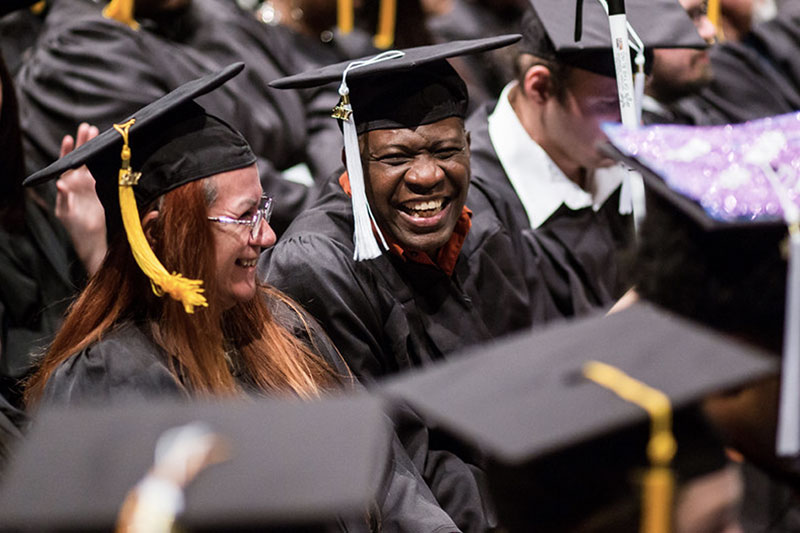The dawn of a new decade calls for a centering moment of reflection. For the team at Sova, as we begin 2020, we pause here to center on and share our core beliefs about large-scale change – how it’s made and sustained in service of a positively transformed student experience.
We share this brief list of key insights as a reminder to ourselves, and to changemakers everywhere, that the work of advancing genuine upward mobility through higher education is complicated work that needs doing more now than ever. Leading this change in American higher education calls for unprecedented commitment and imagination.
Despite the tremendous growth of the “student success” movement over the last decade, the work of remaking institutions to better and more equitably meet the needs of today’s students is still profoundly counter-cultural. It challenges not only long-standing structures, but also deeply held beliefs about the purposes of higher education and the nature of student achievement. Even for access-oriented institutions, the deeply rooted belief that higher education is at least partly about “sorting” carries with it a host of long-standing, profoundly biased assumptions about who can and cannot succeed in college. The imperative to build more just structures and practices for today’s students carries with it the need to systematically unearth and dismantle the assumptions that have long-protected an indefensible status quo in which only a fraction of students ever achieve their goals of improving their lives through education.
Successfully leading student-focused, equity-minded reform requires both clear-eyed understanding of the pervasiveness of structural and cultural barriers to upward mobility and unwavering conviction that colleges and universities can and must do much more to level the playing field. And it requires a refocusing of how change management is understood and supported.
We offer the following key insights to help sharpen thinking and improve practice for all who seek to make our society more just and prosperous through higher education attainment.
1. Thin notions of faculty and staff “buy-in” are insufficient to the work facing colleges that are trying to remake deep structures and long-held beliefs in service of better outcomes for students.
A genuine commitment to equity-minded institutional reform requires not only redesigning programs, processes and systems at scale – it also requires the hard, ongoing work of shifting mindsets and changing attitudes that are deeply ingrained in our institutions’ cultures. And, to complicate matters even more, all of this effort must be undertaken in the context of dynamic environments and under conditions of uncertainty and pressure from multiple directions. Given the realities and imperatives facing colleges, the work of large-scale change is deep work. Many tools and processes exist for managing discrete changes in traditional, private-sector command-and-control environments, but a comparative paucity of resources and growth opportunities exist to build the skills, attitudes, abilities and habits of public higher education leaders at multiple levels to cultivate a strong and ever-expanding sense of shared purpose and co-ownership for student success innovation among faculty, staff, and administrators. And yet, nothing short of true co-ownership will suffice.
2. Case-making and will-building is best understood as iterative, evolving, interactive – it is work without end, but it’s also fun, creative, dynamic, rewarding work.
Because real change is both dynamic and ongoing, leaders are well served by absorbing the idea that systematic, institution-wide change on behalf of better outcomes for students is work that bears a greater resemblance to tending a complex garden over time than it does to building a highway. Unwarranted faith in the power of technical solutions to address adaptive problems have resulted in anemic views of change management and an outdated view of leadership as the domain of visionary individuals at the top of an institution. Senior leadership commitment to change is necessary for progress, but it is also decidedly insufficient for the gains sought and needed. A post-hero approach to leadership places a premium on the skills associated with authentic distribution of authority and sustaining nimble, healthy cross-functional teams amid the inevitability of leadership turnover.
3. The ultimate fate of any truly ambitious student success work will rise or fall according to the quality of relationships that are built and tended to within and across functional divisions.
When it comes to large-scale student success work, complex problems and the change they entail are as much about considering values, weighing tradeoffs, and making hard decisions under conditions of uncertainty as they are about implementing clear-cut evidence-based reforms to practice and policy. Because no idea is strong enough to take the place of high-functioning relationships, emotional intelligence (and a commitment to supporting its cultivation in others) is as important for making change as is a sense of urgency, a compelling vision, strong evidence and clear process. It’s amazing what people are capable of when they’re truly committed to the partnership work required for solving hard problems. The creative commitment of faculty and staff is the greatest resource the institution has when it comes to positively transforming the student experience. Growing and sustaining that creative commitment at many levels is the work of modern leadership.
4. Growth-mindedness is as relevant and important to cultivate among faculty, staff and administrators as it is for students.
Because the work is so hard, complicated and fraught with uncertainty, creating lasting positive change for students requires a deep reservoir of internal motivation on the part of practitioners – especially those closest to students – because no external pressure or evidence is by itself sufficient to inspire faculty and staff to bring their best to courageously remake long-standing practices. A sense of hope, efficacy, resilience and optimism are essential for the ongoing work of making change, and supporting its development in a critical mass of institutional practitioners is a key piece of the student success puzzle. Just as students need to develop productive persistence to help them weather hard times, faculty, staff and administrators seeking to create substantial change in the student experience must cultivate their own productive persistence in the face of inevitable challenges and setbacks.
5. Project and portfolio management skills are absolutely essential for effectively leading complex change over time, but these skills are unfamiliar to many.
Being able to build a Gantt or flow chart is not tantamount to having the skills required to plan workflow in ways that allow teams to implement changes effectively and improve them on an ongoing basis. On the contrary, as the nature of work becomes more adaptive, the ability to communicate effectively in attending to the human side of change is of paramount importance to the work of project management. Project management is best understood as connecting human aspirations with resource workflow realities and enabling the successful implementation of change priorities. It requires the intimate understanding of the “why” and the clear charting of the course from present to future state. Leading change at the institutional level requires strong project management skills to bridge the important work of campus teams that too often occurs in isolation. Attention to cross-functional project management at the outset of implementation and scaling efforts will increase chances of success.




